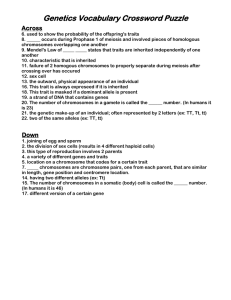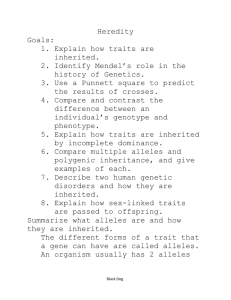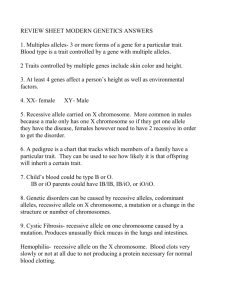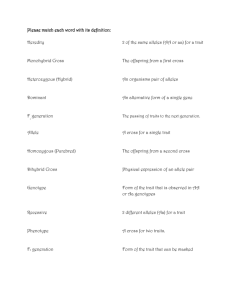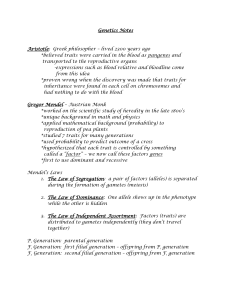Modern Genetics
advertisement
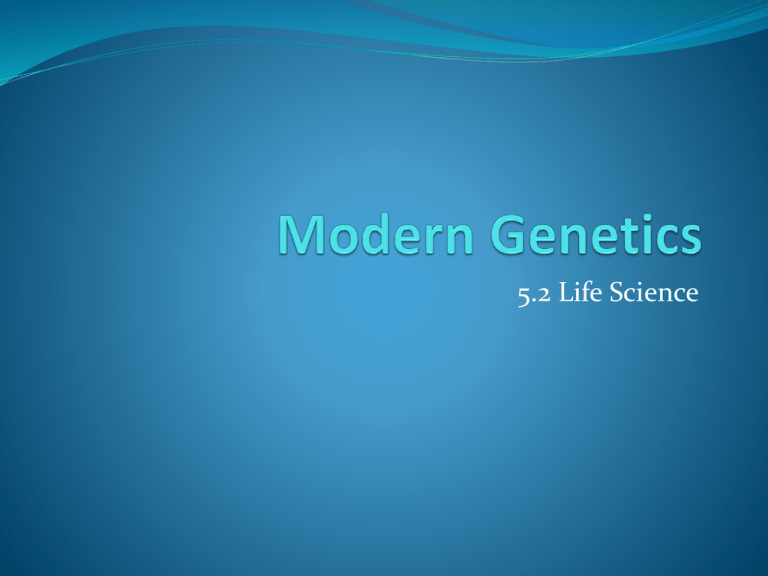
5.2 Life Science Types of Dominance Incomplete Dominance – when the offspring of two homozygous parents show an intermediate (mixed) phenotype Like mixing of paint Example: Some horse breeds can produce a mixture of traits. Chestnut x Carmelo = Palomino (pg. 134) Codominance – when the offspring of two homozygous parents show an combinations phenotype. Both traits are seen. Example: black chicken x white chicken = spotted chicken Multiple Alleles Many traits are controlled by more than two alleles. Traits controlled by multiple alleles produce more than three phenotypes of that trait. Example: Blood Types Blood Types (Alleles) Genotype Blood Type Type of Dominance IA IA or IA i A Dominant IB IB or IB i B Dominant IA IB AB Codominant ii O Recessive Polygenic Traits Eye color is an example of a trait that is produced by a combination of many genes. Other Examples: Skin color, hair color, number of eggs a chicken produces, the color of grain in wheat, etc… It is hard to classify polygenic traits The environment also plays an important role in the expression of traits controlled by polygenic inheritance. Impact of the Environment Your environment plays an important role in the expression of some of your genes. Can be internal or external factors. Example: the sizes of leaves – Trees have certain sizes of leaves based on the type of species it is. If the tree does not receive enough nutrients or water, then the tree will not grow and develop as it should. Or it may receive more than required and the tree does better than it’s genes are designed to do. This is called Genetic Potential. Mutations Mutations are errors in the genetic make-up of an organisms Chromosomal or Gene mutations can occur Not all mutations are harmful May lead to adaptations within a population and then evolution. Mutations occur during DNA replication and Cell Division. They may also occur due to external exposure to chemicals or x-rays. Example: Cancer Chromosome Disorders Having an additional or missing a chromosome can cause the individual to have the wrong number of chromosomes. Nondisjunction may occur during meiosis or mitosis The failure for homologous chromosomes to separate properly resulting in a mutation Crossing-over also occurs during meiosis or mitosis When a piece of a chromosome breaks off and reattaches to a different chromosome or not at all. Types of Genetic Disorders Downs Syndrome Chromosomal Disorder Extra Chromosome on set 21 (XXX instead of XX) Trisomy 21 Can be shorter, exhibit learning disabilities, and may have heart problems Types of Genetic Disorders Cystic Fibrosis Homozygous Recessive Disorder A thick mucus is produced in the lining of the lungs and digestive system Makes it hard to breath and can cause digestion problems as well Physical therapy, special diets, and new medications and drug therapies can help increase life span of patients. Sex Determination Scientist have studied fruit flies because they only have 4 large chromosomes, which make it easy to study. One pair of certain genes are used to determine gender. XX represent female and XY represents male Each egg produced normally contains one X chromosome. Males produce sperm that normally contains either an X or a Y chromosome. Sex-Linked Disorder Some inherited conditions are linked to gender on the X or Y chromosomes. An allele inherited on a sex chromosome is called a sex-linked gene (trait). Color blindness is a sex-linked disorder Recessive allele carried on the X chromosome Because males have only one X chromosome, a male with this allele on his X chromosome is color blind. However, a color blind female must have this allele on both X chromosomes in order to exhibit the trait. Color Blind Punnett Square Sex-Linked Disorders Calico cats are recessive and carried on the X chromosome as well. Two recessive alleles must be present for this allele to be expressed in female cats Pedigrees Trace Traits A pedigree is a visual tool for following a trait through generations of a family. Males are represented by squares and females are represented by circles. A completely filled in circle or square indicates that trait is seen in that person. A half-colored square or circle indicates that the person is a carrier. Heterozygous for the trait. Pedigrees Pedigrees A pedigree is useful tool for studying how traits in a family is inherited over many generations. It can show if the trait is dominant, recessive, or sexlinked. Pedigrees are also used in breeding animals or plants to possibly predict if the desirable traits will be present in the offspring. Issues concerning health also are considered when researching pedigrees.
